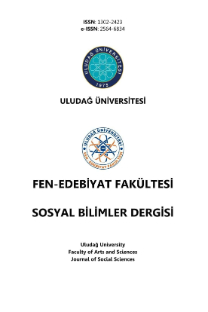I. CONSTANTINUS'UN HRİSTİYANLIĞI MESELESİ ve ÖLÜMÜ HAKKINDAKİ TARTIŞMALAR
The Question of Constantine's Christianity and Discussions on His Death
___
- Amerise, M. (2005). Il Battesimo Di Costantino Il Grande: Storia Di Una Scomoda Eredita. Hermesa- Einzelschriften Book 95. Stuttgart: Franz Steiner Verlag.
- Ammianus Marcellinus, Rerum Gestarum Libri (The Later Roman Empire: A.D. 354-378), Translated by Andrew Wallace-Hadrill and Walter Hamilton, Penguin Classics, London, 1986.
- Aurelius Victor, De Caeseribus, translated with an introduction and commentary by H.W. Bird, Liverpol University Press, Liverpol, 1994. Babelon, Jean (1933). La collection de monnaies et médailles de M. Carlos de Beistegui. Paris.
- Barnes, T.D. (1973). "Lactantius and Constantine". The Journal of Roman Studies, vol. 63, s. 29-46.
- __________ (1985). "Constantine and the Christians of Persia". The Journal of Roman Studies, vol. 75, s. 126-136.
- __________ (1998). "Constantine, Athanasius and the Christina Church". Constantine (History, Historiography and Legend), ed. by Samuel N.C. Lieu and Dominic Montserrat, London-New York: Routledge, s. 7-20.
- Burgess, R.W. (1999). " 'Achyron' or 'proasteion' The Location and Circumstances of Constantine's Death". Journal of Theological Studies, vol. 50, No.1, s. 153-162.
- Cassiodorus, Chronicon (Chronicle), Edition Mommsen, 1894; English translation by Bouke Procee, 2014.
- Daryaee, T. (2009). "Shapur II". Encyclopædia Iranica, online edition available at http://www.iranicaonline.org/articles/shapur-ii, (erişim tarihi 15.02.2017).
- Doğancı, Kamil (2012). "Antik Dönemde Bithynia'dan Geçen Ticari ve Askeri Yollar". Prof. Dr. Ömer Çapar'a Armağan, Ankara: Hel Yayıncılık, s. 93-104.
- Drake, H. A. (1988). "What Eusebius Knew: The Genesis of the 'Vita Constantini'". Classical Philology, vol. 83, s. 20-38.
- Eusebius, De Vita Constantini, Life of Constantine, translated by Averil Cameron and Stuart Hall, Oxford University Press, New York, 1999. Eusebius, Ecclesiastical History, with an English translation by J.E.L. Oulton, Volume II, Books 6-10, Loeb Classical Library No. 265, Harvard University Press, London, 1952.
- Eutropius, Breviarum Historiae Romanae (Roma Tarihinin Özeti), çev: Çiğdem Menzilcioğlu, Kabalcı Yayınevi, Humanitas Dizisi:9, İstanbul, 2007.
- Eutropius, The Breviarium ab urbe condita, A Brief History from the Founding of the City, trans. H.W. Bird, Liverpool University Press, Liverpol, 1993.
- Hughes, B. (2017). A Tale of Three Cities: Istanbul. London: by Weidenfeld & Nicolson. İplikçioğlu, B. (1997). Eskibatı Tarihi I. Ankara: Türk Tarih Kurumu Basımevi.
- Jerome, Chronicon (Chronicle), translated and edited by Roger Pearse and friends, Ipswich, UK, 2005.
- Kaçar, T. (2004). "Üsküdar Savaşları ve Bizans'ın Temelleri". Üsküdar Sempozyumu I (Bildiriler), c. I, İstanbul, s. 21-28.
- ________ (2005). "Origo Constantini Imperatoris-İmparator Constantinus'un Yükselişi". Tarih İncelemeleri Dergisi, c. XX, Sayı:1, s. 135-155.
- ________ (2013). "Roma İmparatorluğu, Hristiyanlar ve Milano Fermanı'nın 1700. Yılı", Toplumsal Tarih. Şubat Sayısı.
- Kaymaz, Y. (2014). "Büyük Constantinus'un Hıristiyanlığı Meselesi". Sakarya Üniversitesi İlahiyat Fakültesi Dergisi, Cilt: XVI, Sayı: 29, s. 213-235.
- Lactantius, De Mortibus Persecutorum (On the Deaths of the Persecutors), Trans. J. Vanderspoel, Ante Nicene Farhers, c.7, Edinburgh, 1994.
- Lieu, S. (1998). "From History to Legend and Legend to History The Medieval and Byzantine Transformation of Constantine's Vita". Constantine (History, Historiography and Legend), ed. by Samuel N.C. Lieu and Dominic Montserrat, London-New York: Routledge, s. 136- 176.
- Malalas, The Chronicle of John Malalas, A Translation, a translation by. E. Jeffreys, M. Jeffreys & R. Scott vd., Melbourne, 1986.
- Miller, K. (1962). Die Peutingersche Tafel. Stuttgart: F.A.
- Mitchell, S. (1998). "The Cities of Asia Minor in the Age of Constantine". Constantine (History, Historiography and Legend), ed. by Samuel N.C. Lieu and Dominic Montserrat, London-New York: Routledge, s. 52-73.
- Norwich, J.J. (2013). Bizans (Erken Dönem MS 323-802). çev: Hamide Koyukan, İstanbul: Kabalcı Yayınevi.
- Orosius, Historiarum Adversum Paganos (History Against the Pagans), translated by I.W. Raymond, Columbia University Press, New York, 1936.
- Orosius, Historiarum Adversum Paganos, Libri VII, ed. C. Zangemeister, Corpus Scriptorum Ecclesiasticorum Latinorum, Vol. 5, Vienna, 1882.
- Ostrogorsky, G. (1981). Bizans Devleti Tarihi. Ankara: Türk Tarih Kurumu Yayınları.
- Özçelik, F. (2008). Vita Constantini Kutsal İmparator Constantinus'un Hayatı. Yüksek Lisans Tezi. Balıkesir: Balıkesir Üniversitesi. Pohlsander, H.A. (2004). The Emperor Constantine. New York: Routledge.
- RIC: Roman Imperial Coinage: vol. VII: Constantine and Licinius (A.D. 313-337), ed. by C.H.V. Sutherland and D. Litt, London 1966. Rohrbacher, D. (2002). The Historians of Late Antiquity. London and New York: Routledge.
- Salway, B. (2001). "Travel, Itineraria and Tabellaria". Travel and Geography in the Roman Empire. ed. by Colin Adams and Ray Laurence, New York, s. 22-66.
- Stephenson, P. (2016). Büyük Konstantin. çev: Gürkan Ergin, İstanbul: Türkiye İş Bankası Kültür Yayınları. Stevenson, J. (2003). "Lactantius". New Catholic Encyclopedia. Washington, vol. VIII, s. 274.
- Vasiliev, A.A. (2016). Bizans İmparatorluğu Tarihi. çev. Tevabil Alkaç. İstanbul: Alfa Basım Yayım.
- Woods, D. (1997). "Where Did Constantine I Die?". Journal of Theological Studies, Vol. 48:2, s. 531-535.
- Zosimus, Nea Historia (New History), A translation with commentary by Ronald T. Ridley, Australian Association for Byzantine Studies, Canberra, 1982.
- ISSN: 1302-2423
- Yayın Aralığı: 2
- Başlangıç: 1999
- Yayıncı: Bursa Uludağ Üniversitesi
ÇOCUK HAKLARI VE EĞİTİMİNE PSİKOLOJİK BİR BAKIŞ
KOCA SİNAN PAŞA HAKKINDA ÖVGÜ ve YERGİ İKİLEMİ
TOPLUMSAL BELLEK BAĞLAMINDA MEZUNLARIN ANLATIMIYLA KÖY ENSTİTÜLERİ DENEYİMİ
I. CONSTANTINUS'UN HRİSTİYANLIĞI MESELESİ ve ÖLÜMÜ HAKKINDAKİ TARTIŞMALAR
BEETHOVEN'IN SON DÖNEM ÜSLUBU, SON PİYANO SONATLARI ve "OP. 106, HAMMERKLAVİER"
I. CONSTANTINUS'UN HRİSTİYANLIĞI MESELESİ ve ÖLÜMÜ HAKKINDAKİ TARTIŞMALAR
PATIENTS and HEALERS in "ZAABALAWI" by NAGUIB MAHFOUZ and A STRANGENESS IN MY MIND by ORHAN PAMUK
